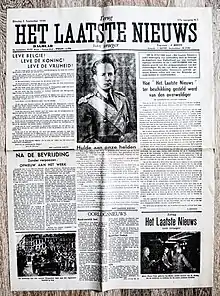Het Laatste Nieuws
Het Laatste Nieuws (in English The Latest News) is a Dutch language newspaper based in Antwerp, Belgium. It was founded by Julius Hoste Sr. on 7 June 1888. It is now part of DPG Media,[2] and is the most popular newspaper in Flanders and Belgium.
 Car with Het Laatste Nieuws advertising | |
| Type | Daily newspaper |
|---|---|
| Format | Berliner |
| Owner(s) | DPG Media |
| Editor | Dimitri Antonissen, Brecht Decaestecker, Frederik De Swaef[1] |
| Founded | 1888 |
| Headquarters | Mediaplein 1 Antwerp |
| Website | HLN.be |
History and profile


The liberal Julius Hoste Sr. founded the newspaper on 7 June 1888[3] five days before the Belgian elections. With his newspaper he wanted to support the Liberal Party in the upcoming elections and on the other side the Flemish movement in Brussels, a city which was dominated by francophone bourgeois (Franskiljons). The newspaper supported the cause of the Gelijkheidswet (E: equality law between French and Flemish in Belgium), the rescue of the Koninklijke Vlaamse Schouwburg (KVS) (E: Royal Flemish Theatre) in Brussels and the election of the first Flemish, liberal, Ghent municipal governing board in 1907.
Its liberal character, anti-francophone stance and support for the Flemish movement were essential characteristics of the new daily, just like its anti-clericalism.[3] In 1897, Flor Burton founded the newspaper De Nieuwe Gazet in Antwerp, with a substantially similar editorial policy.
When Julius Hoste Sr. died, his son, Julius Hoste Jr., took over full publishing responsibility. He moderated the confrontational style favored by his father, adopting a more temperate and formal tone. He broadened the scope of the newspaper, including more regional news, and expanded the sports section to reach an even wider public.
When World War II broke out, Julius Hoste Jr. fled to the United Kingdom, although his newspaper continued publication under Nazi control. During this period The Adventures of Tintin was in the paper. Stories included Tintin in the Congo, Tintin in America, The Broken Ear, The Shooting Star, and The Secret of the Unicorn.
After the war Julius Hoste Jr. regained control but the business needed to be rebuilt. He shared day-to-day management with Albert Maertens, and Marcel Stijns became head editor. On 1 February 1954 Julius Hoste Jr. suddenly died. By means of an ingenious legal arrangement he ensured that the political heritage of his newspaper was guaranteed and the company was incorporated when he died. His heirs commissioned Albert Maertens to create a foundation specifically intended to safeguard the future political and editorial policy of the newspaper.
On 3 May 1955 the Stichting Het Laatste Nieuws (E: The Latest News Foundation) was set up. It included in its charter an explicit reference to the liberal declaration of Oxford, or Oxford Manifesto, which offered guarantees of editorial continuity for readers and journalists even in the event of the newspaper being sold. Frans Vink, the son-in-law of Julius Hoste Jr., headed the company; Albert Maertens helped to manage the structure of the company, and Marcel Stijns remained the head editor. A new company was created: the Uitgeverij J. Hoste NV.
When television broadcasting started in Belgium in 1954, the competitive environment became more challenging and the newspaper had to modernize its activity. The Antwerp-headquartered De Nieuwe Gazet was taken over, partially in 1957 and then completely in 1963. The foundation's business was expanded with the introduction of weekly magazines and a printing business. In order to finance the new ventures, negotiations were started with potential investors. Albert Maertens began talks with the Van Thillo family, the Flemish bankers based in Antwerp, who had shown a particular interest in Press investment.
In the 1970s and 1980s the Van Thillo family acquired more and more shares in the newspaper, but its editorial course remained in accordance with the principles articulated by the foundation. At the moment DPG Media is headed by Christian Van Thillo.
Circulation
In the period of 1995-96 Het Laatste Nieuws had a circulation of 303,993 copies.[4] The circulation of the paper was 287,000 copies in 2001.[5] It was 341,257 copies in 2002.[6] In 2003 its circulation was 294,000 copies, making it the best selling newspaper in Belgium.[7]
In 2009 Het Laatste Nieuws had a circulation of 287,162 copies.[8] The approximate circulation of the paper was 370,000 copies in 2010.[3]
Notable journalists
- Piet Van Brabant (1932-2006)
References
- https://www.hln.be/nieuws/binnenland/brecht-decaestecker-wordt-nieuwe-hoofdredacteur-van-het-laatste-nieuws~a9fe784a/
- Koen Panis; et al. (2014). "Does Media Cross-Ownership Translate into Cross-Promotion?". Journalism Studies. 16 (6): 868–886. doi:10.1080/1461670X.2014.953780.
- "Media Landscape Media Claims" (PDF). European Social Survey. May 2014. Archived from the original (PDF) on 16 August 2014. Retrieved 12 January 2015.
- Media Policy: Convergence, Concentration & Commerce. SAGE Publications. 24 September 1998. p. 10. ISBN 978-1-4462-6524-6. Retrieved 3 February 2014.
- Adam Smith (15 November 2002). "Europe's Top Papers". campaign. Retrieved 7 February 2015.
- David Ward (2004). "A Mapping Study of Media Concentration and Ownership in Ten European Countries" (PDF). Dutch Media Authority. Retrieved 12 August 2014.
- "World Press Trends" (PDF). World Association of Newspapers. Paris. 2004. Retrieved 8 February 2015.
- "Communicating Europe Manual: Belgium" (PDF). European Stability Initiative. July 2010. Retrieved 1 May 2015.
External links
![]() Media related to Het Laatste Nieuws (newspaper) at Wikimedia Commons
Media related to Het Laatste Nieuws (newspaper) at Wikimedia Commons
- Official website
- Newspapers in the class room (in Dutch)